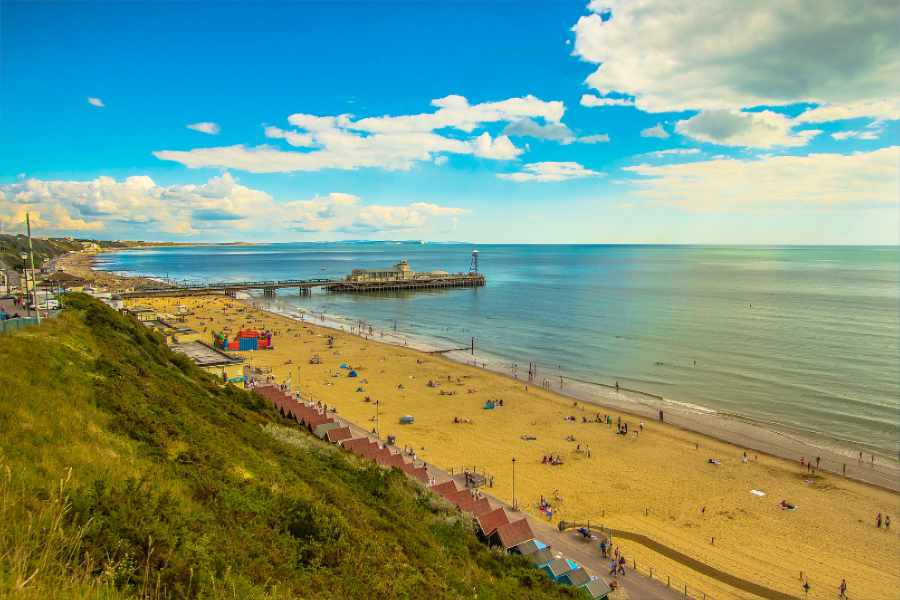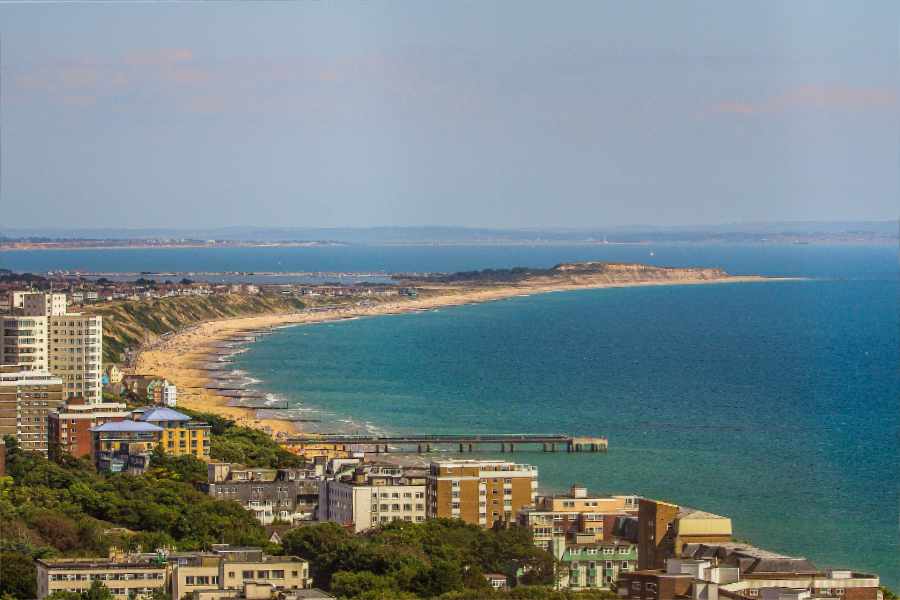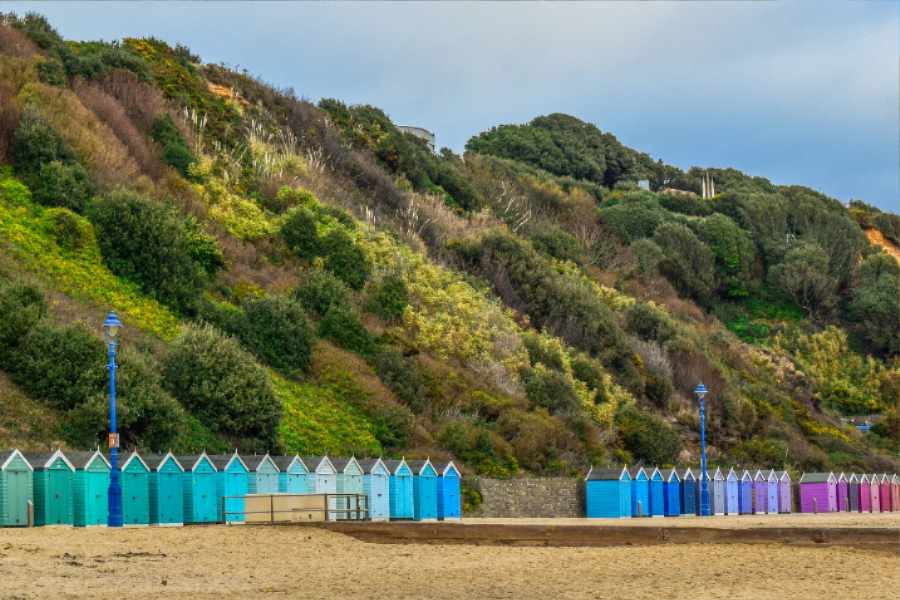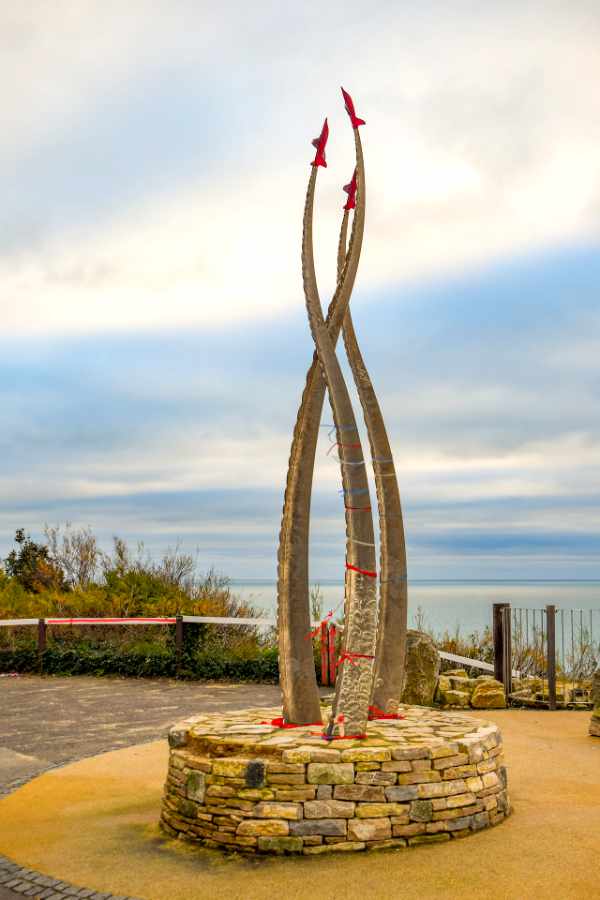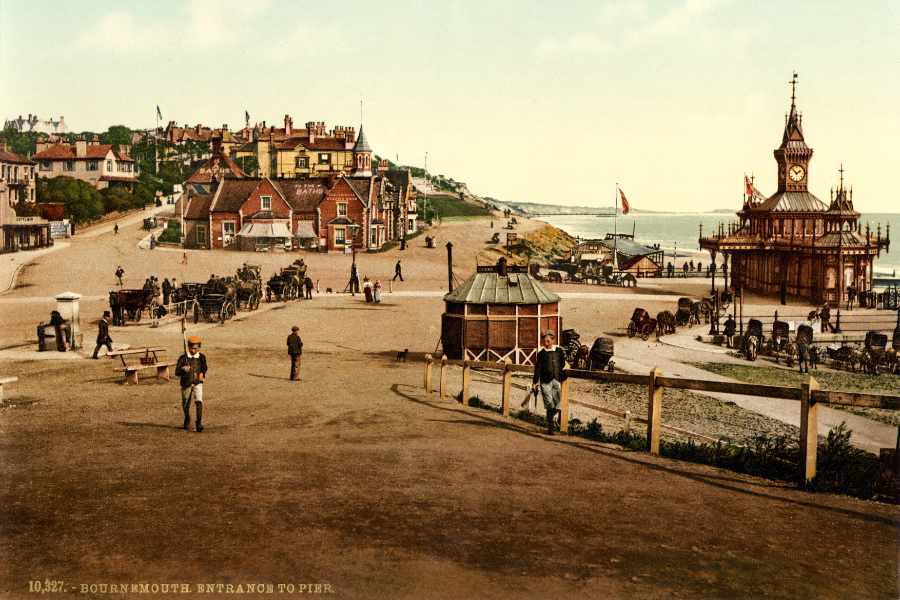Bournemouth
Beautiful Beaches, Hotels and Attractions
Bournemouth is one of Dorset’s most popular towns ~ its long golden beach stretching from Sandbanks in the west to Hengistbury Head in the east make it a popular destination for tourists.
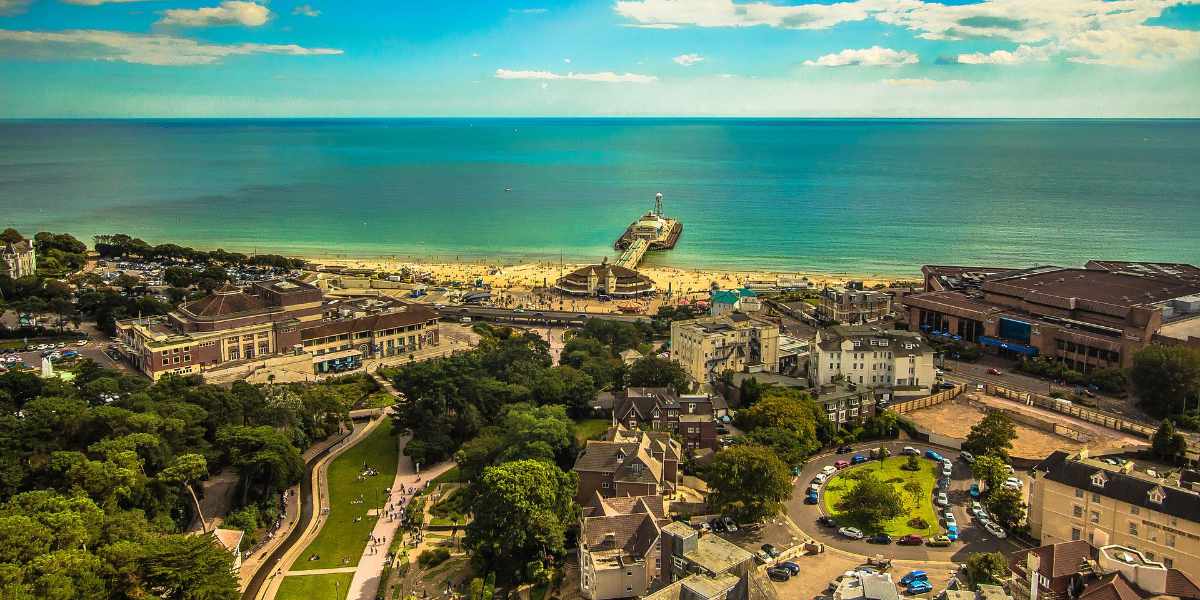
Bournemouth Beach, Pier, Pavilion and Lower Gardens
Bournemouth is one of Dorset’s best known coastal resorts. It has a population of around 200,000 people and is a popular tourist destination due to its sandy beaches, mild climate, and Victorian architecture.
Bournemouth has a rich history, with evidence of human settlement in the area dating back to the Bronze Age. It was officially founded in the early 19th century as a health resort, and quickly grew in popularity thanks to its natural beauty and the introduction of the railway.
Today, Bournemouth is known for its vibrant nightlife, cultural events, and outdoor activities. The town has a number of museums and galleries, including the Russell-Cotes Art Gallery & Museum, which houses a collection of Victorian and Pre-Raphaelite art, and the Bournemouth Aviation Museum, which is dedicated to the history of aviation in the area.
Bournemouth’s beaches are some of the most popular in the UK, and are known for their soft sand and clean water. The town is also home to a number of parks and gardens, including the Lower Gardens, which feature a range of exotic plants and a miniature golf course. Every winter the gardens are illumitanted with Christmas lights and an outdoor ice rink (see list of regular events below).
Bournemouth Beach
With seven miles of golden sand and a wide range of amenities, Bournemouth Beach is a popular spot for both locals and tourists. The beach boasts stunning views of the Isle of Wight and the Purbeck Hills, making it the perfect location for a relaxing day out.
There are plenty of activities available at Bournemouth Beach, including water sports such as surfing, kayaking, and paddle boarding. The beach also features a pier (built in 1880) with attractions such as a zip wire and a climbing wall. Visitors can enjoy a variety of food and drink options, from beachside cafes and restaurants to ice cream stands.
Bournemouth Beach has received numerous awards, including the Marine Conservation Society Award for protecting the sea and the wildlife it contains, its cleanliness and water quality. It’s a must-visit destination at anytime of the year for anyone wanting to experience the beauty of the Dorset coast.
Bit of History
In the 12th century the region around the mouth of the River Bourne was part of the Hundred of Holdenhurst. The hundred later became the Liberty of Westover when it was extended to include the settlements of North Ashley, Muscliff, Muccleshell, Throop, Iford, Pokesdown, Tuckton and Wick, and incorporated into the Manor of Christchurch. Although the Dorset and Hampshire region surrounding it had been the site of human settlement for thousands of years, Westover was largely a remote and barren heathland before 1800. In 1574 the Earl of Southampton noted that the area was “Devoid of all habitation“, and as late as 1795 the Duke of Rutland recorded that “… on this barren and uncultivated heath there was not a human to direct us“.
In the late 19th and early 20th centuries the Borough of Bournemouth would grow to encompass a number of ancient settlements along the River Stour, including Longham where a skull thought to be 5,500 years old was found in 1932. Bronze Age burials near Moordown, and the discovery of Iron Age pottery on the East Cliff in 1969, suggest there may have been settlements there during that period. Hengistbury Head, added to the borough in 1932, was the site of a much older Palaeolithic encampment. During the latter half of the 16th century James Blount, 6th Baron Mountjoy, began mining for alum in the area, and at one time part of the heath was used for hunting, although by the late 18th century little evidence of either event remained. No-one lived at the mouth of the Bourne river and the only regular visitors to the area before the 19th century were a few fishermen, turf cutters and gangs of smugglers.
Prior to the Christchurch Inclosures Act 1802, more than 70% of the Westover area was common land. The act, together with the Inclosure Commissioners’ Award of 1805, transferred 5,000 acres (2,000 ha) into the hands of five private owners, including James Harris, 1st Earl of Malmesbury, and Sir George Ivison Tapps. In 1809 the Tapps Arms public house appeared on the heath. A few years later, in 1812, the first official residents, retired army officer Lewis Tregonwell and his wife, moved into their new home built on land purchased from Tapps. The area was well known to Tregonwell who, during the Napoleonic wars, spent much of his time searching the heath and coastline for French invaders and smugglers.
Anticipating that people would come to the area to indulge in the newly fashionable pastime of sea-bathing, an activity with perceived health benefits, Tregonwell built a series of villas on his land which he hoped to let out. The common belief that pine-scented air was good for lung conditions, and in particular tuberculosis, prompted Tregonwell and Tapps to plant hundreds of pine trees. These early attempts to promote the town as a health resort meant that by the time Tregonwell died in 1832, Bournemouth had grown into a small community with a scattering of houses, villas and cottages. The town would ultimately grow up around the scattered pines and tree-lined walk to the beach, later to become known as the Invalids’ Walk.
After the death of Tapps in 1835, his son Sir George William Tapps-Gervis inherited his father’s estate. He hired the young local architect Benjamin Ferrey to develop the coastal area on the east side of the stream. Bournemouth’s first hotel, later to become part of the Royal Bath Hotel, opened in 1838 and is one of the few buildings designed by Ferrey still standing. Bournemouth grew at a faster rate as Tapps-Gervis began developing the area similarly to the south coast resorts of Weymouth and Brighton. In 1841 Tapps-Gervis invited the physician and writer Augustus Granville to stay. Granville was the author of The Spas of England, which described health resorts around the country, and he included a chapter on Bournemouth in the second edition of his book. The publication of the book, and the increase in visitors seeking the medicinal use of seawater and the pine-scented air, helped the town to grow and establish itself as an early tourist destination.
In the 1840s Benjamin Ferrey was replaced by Decimus Burton, whose plans for Bournemouth included the construction of a garden alongside the Bourne stream, an idea first mooted by Granville. The fields south of the road crossing (later Bournemouth Square) were drained and laid out with shrubberies and walks. Many of these paths, including the Invalids’ Walk, remain in the town today. A second suggestion of Granville’s, a sanatorium, was completed in 1855 and greatly raised Bournemouth’s profile as a place for recuperation.
At a time when the most convenient way to arrive in the town was by sea, a pier was considered to be a necessity. Holdenhurst Parish Council was reluctant to find the money, and an attempt to raise funds privately in 1847 had only succeeded in financing a small 100 feet (30 m) jetty. The Bournemouth Improvement Act of 1856 granted greater financial autonomy to the town and a pier was approved that year. A number of wooden structures were built before an 838 feet (255 m) cast iron design by Eugenius Birch was completed in 1880. Under the Act, a board of 13 Commissioners was established to build and organise the expanding infrastructure of the town, including paving, sewers, drainage, street lighting and street cleaning.
The arrival of the railways in 1870 precipitated a massive growth in seaside and summer visitors to the town, especially from the Midlands and London. In 1880 the town had a population of 17,000, but by 1900, when railway connections to Bournemouth were at their most developed, the town’s population had risen to 60,000 and it had become a favourite location for visiting artists and writers. The town was improved greatly during this period through the efforts of Sir Merton Russell-Cotes, the town’s mayor and a local philanthropist, who helped to establish the town’s first library and museum. The Russell-Cotes Art Gallery & Museum was housed in his mansion, and after his death, it was given to the town. Bournemouth became a municipal borough in 1890 and a county borough in 1900.
As Bournemouth’s growth increased in the early 20th century, the town centre spawned theatres, cafés, two art deco cinemas, and more hotels. Other new buildings included the war memorial in 1921 and the Bournemouth Pavilion, the town’s concert hall and grand theatre, finished in 1925.
Regular Events in Bournemouth
SandFest – Sandbanks music festival
Summer Live – Free events celebrating the best of Bournemouth
Rockley’s Summer Spectacular with Fireworks – Fireworks and Fun in Poole
Bournemouth Air Festival – Annual festival and air show
Bournemouth Arts by the Sea Festival – annual arts festival
Bournemouth Christmas Tree Wonderland – annual Christmas lights festival
Photos of Bournemouth
